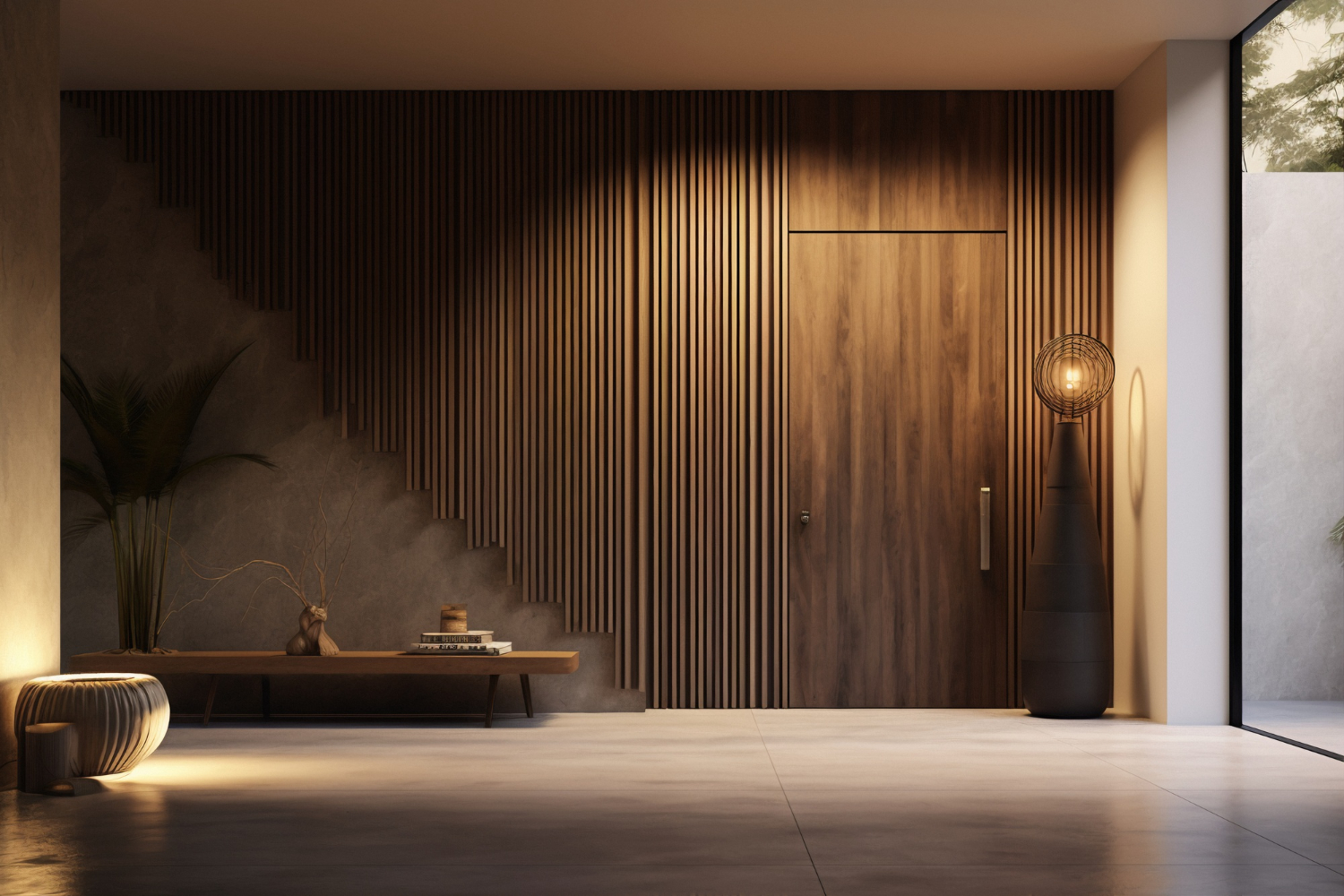
Interior wall cladding is a popular choice for modern homes, offering a blend of beautiful appearance and functional benefits. It not only enhances the visual interest of your interiors but also provides durability and insulation.
This article explores the various aspects of cladding, focusing on how it can transform your living spaces, especially bedrooms, with style and smoothness.
Modern interior wall designs are all about simplicity, clean lines, and a minimalist approach.
Geometric Patterns
Geometric patterns in the wall create a modern and artistic look. Whether it’s using wood, metal, or stone, geometric designs add a modern flair to any room.
Textured Panels
Textured panels bring a tactile element to your interiors. Materials like 3D wall panels can create stunning visual effects and add depth to your walls.
Mixing Materials
Combining different materials in cladding can create unique and eye-catching designs. For instance, mixing wood with metal or stone can result in a distinctive and modern look.
Preparation
Proper preparation of the wall surface is crucial for successful cladding installation. The wall should be clean, dry, and free from any obstructions.
Measuring and Cutting
Accurate measurements and precise cutting of cladding panels ensure a perfect fit. It’s essential to use the right tools and techniques to avoid any gaps or misalignments.
Fixing and Securing
The cladding panels need to be securely fixed to the wall using appropriate adhesives or fasteners. It’s important to follow the manufacturer’s instructions for the best results.
Finishing Touches
Once the cladding is installed, finishing touches like trimming and sealing the edges add a polished and professional look to the installation.
Cleaning
Regular cleaning with a soft cloth or brush helps maintain the appearance of the cladding. For wooden cladding, using a suitable wood cleaner is recommended.
Repairs
Addressing any damages or cracks promptly can prevent further decline. It’s advisable to keep some spare panels for future repairs.
Sealing
Sealing stone and brick cladding can protect them from moisture and stains. It’s important to reapply the sealant periodically as per the manufacturer’s recommendations.
Wall cladding has become a staple in modern interior design. Its creativity allows homeowners to experiment with different materials, textures, and colors to create unique and modern looks.
Whether you want to add a rustic charm with wooden panels or achieve a sleek, minimalist look with stone or metal, it offers endless possibilities.
Modern homes often incorporate walls to make a bold statement or to create a focal point in a room. The choice of materials can significantly impact the overall feel of the space, making it warm and inviting or cool and industrial.
When it comes to interior wall cladding, there are several materials to choose from, each offering distinct characteristics and benefits.
Wooden cladding adds warmth and texture to any room. It's perfect for creating a cozy and inviting atmosphere, making it a popular choice for living rooms and bedrooms. Available in various finishes and grains, wooden panels can be arranged in different patterns to achieve a custom look.
Stone cladding is ideal for those looking to add a touch of luxury and elegance to their interiors. It's durable and can withstand wear and tear, making it a great option for high-traffic areas. Natural stone, like slate or granite, can give your home a timeless interest.
For a modern and industrial look, metal cladding is an excellent choice. Metals like aluminum and stainless steel can be used to create sleek and reflective surfaces that enhance the modern feel of a space. This type of cladding is also low-maintenance and durable.
Brick cladding brings a rustic and vintage charm to interiors. It's perfect for creating an exposed brick wall effect without the need for structural modifications. Brick panels are easy to install and can add texture and depth to your rooms.
Bedroom wall cladding are personal sanctuaries where comfort and style go hand in hand. They can play a crucial role in enhancing the look and vibrations of a bedroom.
Creating a Focal Point
Using a wall to create a focal point behind the bed is a popular trend. This not only draws attention to the bed but also adds a layer of texture and visual interest. Materials like wood or stone are often chosen for this purpose, as they bring warmth and a sense of coziness.
Adding Depth and Texture
Cladding the walls of a bedroom can add depth and texture, making the space feel more dynamic and inviting. Textured materials like brick or wood can break the monotony of plain walls and introduce an element of intrigue.
Enhancing Acoustic Properties
They can also enhance the acoustic properties of a bedroom. Materials like wood and fabric panels can absorb sound, reducing noise levels and creating a quieter, more peaceful environment.
Personalizing the Space
Wall cladding allows for personalization of the bedroom space. With various materials, colors, and patterns available, homeowners can choose a design that reflects their personal style and complements the overall theme of the room.
Wall cladding is a variable and stylish way to enhance the interiors of modern homes. Whether it’s adding warmth with wooden panels, luxury with stone, or an industrial touch with metal, it offers endless design possibilities.
When used in bedrooms, it can create a cozy and personalized space that reflects individual style. With proper installation and maintenance, it can transform any room into a modern and smooth retreat.
1. What materials are best for interior walls?
Wood, stone, metal, and brick are popular materials for interior walls, each offering unique benefits and beauty.
2. How do I choose the right wall cladding for my bedroom?
Consider factors like the overall theme, color scheme, and desired vibrations. Wooden cladding adds warmth, while stone and metal offer a modern touch.
3. Is wall cladding suitable for all rooms?
Yes, they can be used in any room, including bedrooms, living rooms, and kitchens. It’s essential to choose the right material for each space.
4. How do I maintain my wall cladding?
Regular cleaning, prompt repairs, and periodic sealing (for stone and brick) help maintain the appearance and longevity of walls.
5. Can I install wall cladding myself?
While it’s possible to install wall cladding as a self build project, professional installation ensures a perfect fit and finish, especially for complex designs.












